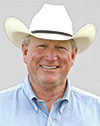Videos and live demonstrations are used most often and most appear to use docile cattle for these teaching opportunities.
Almost without exception, someone will ask the question or will make the comment: “This is all fine, but what about working wild cattle or those wanting to fight? This stuff won’t work on them.”
Cattle that are “wild” or wanting to fight are just expressing behavior in response to what they perceive as a predator-prey interaction.
Prey animals respond to what they perceive to be predatory behavior in one of two ways: flight or fight. Cattle associate people as predators as a result of being mishandled.
Flight or fight
One goal of stockmanship is to never elicit a predator-prey response. Many people handling livestock do not know that they are doing things that initiate that response in cattle. This flight-or-fight response in cattle when they are being handled is created (and corrected) by humans.
If gathering or processing cattle is a “wreck” nearly every time cattle are corralled and processed, the owner or manager needs to step back and determine the cause of such behavior. Often this may be only one or a few cows that display the tendency to fight, but it is normally a symptom of a much larger issue and stress level in the herd.
One issue observed with people handling cattle that are acting as if they want to fight is those cattle tend to be the focus and get all the attention from handlers. Focusing attention on these cattle and trying to make them get with the herd is one of the worst things that can happen. Focusing on them reaffirms that you are preying on them.
The exact opposite needs to happen when working aggressive cattle within a herd. Work around these cattle and get movement while allowing the one wanting to fight the opportunity to rejoin the herd. Most of the time, the initial fight response will be in a protective mode trying to keep the person away from a calf or the rest of the herd.
Avoiding isolation
If you watch wild game such as bison or buffalo, they will posture up on predators until the herd has a chance to move and will then return to the herd. They will continue this process until the threat is gone.
One thing they will not do is get themselves isolated from the group. Isolation from the herd would certainly lead to attack. If they continue to feel threatened, more animals will demonstrate the fight response as a show of force.
Cattle will react similarly. The group needs to perceive the risk is subsiding. That can only occur by the way the handler works around the herd. Moving the herd away from the one wanting to fight while allowing it the opportunity to return will demonstrate non-predatory behavior.
“Fight or flight” is a response to incorrect pressure and very often to prolonged pressure where cattle do not perceive an alternative way to escape.
What lies ahead
It may not be pressure in the pasture that creates stress, but what they know is coming in the corral if they allow themselves to be gathered. A sign of this behavior can be seen in cattle on a large number of ranches and farms.
The most common scene is one where a trailer pulls into a pasture with either ATVs or horses on board, and the cattle go to moving away and often at a rapid speed. That is a direct response to what they perceive to be the beginning of a bad experience or predatory handling.
To stop this behavior the cattle have to be handled more frequently, not less. More frequently and less stressfully. Remember the definition of insanity … doing the same thing over and over and expecting different results.
If the desire is to have cattle act differently, then people have to behave differently and teach cattle that being herded by people is not going to be a bad experience.
A careful pursuit
It does not matter what means of transportation is used in working with cattle; it is more about position and pressure-release. In dealing with flighty cattle, do not reinforce the behavior by chasing after or even rushing to get around them.
If cattle run or trot away, simply go to them in a walk or at an idle, if in a vehicle. When approached, they will normally take off again as soon as the flight zone is penetrated. The flight zone on some cattle will be as large as the area they can see or hear people coming.
Slow down at the edge of the flight zone, and if any cattle posture in fight response, back up a step or two. This signals to the cattle that you understand you are pressuring them and are willing to step back and remove that pressure.
If they leave again, which they will, continue trailing them until the cattle will walk away slowly. With every approach, the cattle should leave slower until they do not move without intentional pressure to start movement. Realize this could take a significant amount of time and should not be attempted on a day when they have to be gathered.
Bad habits are neither created nor corrected in one day. If a group of cows cannot be started, directed and stopped by one person, they need to be worked more in pastures. ![]()
PHOTO
The flight zone on some cattle will be as large as the area they can see or hear people coming. Slow down at the edge of the flight zone, and if any cattle posture in fight response, back up a step or two. Photo by Mike Dixon.








